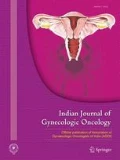Abstract
Purpose
To investigate the survival and fertility outcomes of the patients treated for gestational trophoblastic neoplasia (GTN).
Methods
The clinical records of all the GTN patients registered and treated between January 1, 2008, and December 31, 2013, at a regional cancer center (RCC) in Tamil Nadu, India, were reviewed. About 35 patients with GTN were identified; 29 patients were included in the study. Methotrexate and the EMACO (Etoposide, Methotrexate, Adriamycin, Cyclophosphamide, and Vincristine) regimen were administered based on the risk score evaluation, beta human chorionic gonadotropin (HCG) levels were tested during follow-ups, and annual ultrasonography and chest radiography were performed.
Results
Approximately 15 (51.7%) and 14 (48.3%) patients had low- and high-risk scores, respectively. Five patients (17.2%) underwent hysterectomy, and 21 (72.4%) underwent chemotherapy. Twenty-eight patients (96.6%) survived, and only one (3.4%) died after the treatment because of lung metastasis and pulmonary infections. The overall survival rate in the primary setting was 96.6%. With regard to child-bearing outcomes, 14 patients (48.3%) did not desire a child. Of 15 women who wished to conceive after the treatment, 9 could not conceive, 3 had abortions, and 3 had a normal delivery.
Conclusion
The diagnosis was made using radiological imaging and beta HCG levels for low- and high-risk patients, and the follow-up management was effective in yielding a fertility outcome where patients were able to resume normal reproductive functions. GTN is a highly curable malignancy regardless of the stage and its metastatic nature.
Similar content being viewed by others
References
Seckl MJ, Sebire NJ, Berkowitz RS. Gestational trophoblastic disease. Lancet. 2010;376(9742):717–29.
Lurain JR. Gestational trophoblastic disease I: epidemiology, pathology, clinical presentation and diagnosis of gestational trophoblastic disease, and management of hydatidiform mole. Am J Obstet Gynecol. 2010;203(6):531–9.
Hertig AT. Hydatidiform mole and chorionepithelioma. In: Meigs JV, Sturgis SH, editors. Progress in gynaecology, vol. 2. New York: Grune and Stratton; 1950. p. 372–94.
Park WW. Choriocarcinoma: a study of its pathology. London: William Heinemann Medical Books; 1971. p. 58.
Berkowitz RS, Goldstein DP. Chorionic tumors. N Engl J Med. 1996;335:1740–8.
Berkowitz RS, Goldstein DP. Clinical practice. Molar pregnancy. N Engl J Med. 2009;360:1639–45.
Goldstein DP, Berkowitz RS. Current management of gestational trophoblastic neoplasia. HematolOncolClin North Am. 2012;26:111–31.
Lurain JR. Gestational trophoblastic disease II: classification and management of gestational trophoblastic neoplasia. Am J Obstet Gynecol. 2011;204(1):11–8.
Newlands ES. The management of recurrent and drug-resistant gestational trophoblastic neoplasia (GTN). Best Practice Res Clin Obstet Gynaecol. 2003;17(6):905–23.
Ilancheran A. Optimal treatment in gestational trophoblastic disease. Ann Acad Med Singap. 1998;27:698–704.
Alazzam M, Tidy JA, Hancock BW, Osborne R. First line chemotherapy in low risk gestational trophoblastic neoplasia. Cochrane Database Syst Rev. 2009;1:CD007102.
Gulia S, Bajpai J, Gupta S, Maheshwari A, Deodhar K, Kerkar RA, Menon S. Outcome of gestational trophoblastic neoplasia: experience from a tertiary cancer centre in India. Clin Oncol. 2014;26(1):39–44.
Turan T, Karacay O, Tulunay G, Boran N, Koc S, Bozok S, Kose MF. Results with EMA/CO (etoposide, methotrexate, actinomycin D, cyclophosphamide, vincristine) chemotherapy in gestational trophoblastic neoplasia. Int J Gynecol Cancer. 2006;16(3):1432–8.
Ngan S, Seckl MJ. Gestational trophoblastic neoplasia management: an update. Curr Opin Oncol. 2007;19(5):486–91.
Berkowitz RS, Bernstein MR, Laborde O, Goldstein DP. Subsequent pregnancy experience in patients with gestational trophoblastic disease. New England Trophoblastic Disease Center, 1965–1992. J Reprod Med. 1994;39(3):228–32.
Berkowitz RS, Goldstein DP. Current management of gestational trophoblastic diseases. GynecolOncol. 2009;112:654–62.
Diver E, May T, Vargas R, Bernstein M, Goldstein D, Berkowitz R. Changes in clinical presentation of postterm choriocarcinoma at the New England Trophoblastic Disease Center in recent years. Gynecol Oncol. 2013;130(3):483–6.
Macdonald MC, Ram R, Tidy JA, Hancock BW. Choriocarcinoma after a nonterm pregnancy. J Reprod Med. 2010;55(5–6):213–8.
Anfinan N, Sait K, Sait H. Gestational trophoblastic disease in the western region of Saudi Arabia (single-institute experience). Eur J Obstet Gynecol Reprod Biol. 2014;180:8–11.
Goto S, Ino K, Mitsui T, Kikkawa F, Suzuki T, Nomura S, Mizutani S. Survival rates of patients with choriocarcinoma treated with chemotherapy without hysterectomy: effects of anticancer agents on subsequent births. Gynecol Oncol. 2004;93(2):529–35.
Song HZ, Wu PC, Wang YE, Yang XY, Dong SY. Pregnancy outcomes after successful chemotherapy for choriocarcinoma and invasive mole: long-term follow-up. Am J Obstet Gynecol. 1988;158(3):538–45.
Gadducci A, Cosio S, Fanucchi A, Tana R, Manacorda S, Pistolesi S, Strigini FL. Prognosis of patients with gestational trophoblastic neoplasia and obstetric outcomes of those conceiving after chemotherapy. Anticancer Res. 2016;36(7):3477–82.
Cyriac S, Rajendranath R, Sridevi V, Sagar TG. Management of high-risk gestational trophoblastic neoplasia with etoposide, methotrexate, actinomycin D, cyclophosphamide, vincristine chemotherapy. J Reprod Med. 2011;56(5–6):219–23.
Cyriac S, Rajendranath R, Sridevi V, Sagar TG. Etoposide, cisplatin–etoposide, methotrexate, actinomycin-D as primary treatment for management of very-high-risk gestational trophoblastic neoplasia. Int J Gynecol Obstet. 2011;115(1):37–9.
Chemotherapy for GTD, American Cancer Society, (2017) Retrieved from https://www.cancer.org/cancer/gestational-trophoblasticdisease/treating/chemotherapy.html.
Alazzam M, Tidy J, Osborne R, et al. Chemotherapy for resistant or recurrent gestational trophoblastic neoplasia. Cochrane Database Syst Rev. 2012;12:CD008891.
Soper JT, Mutch DG, Schink JC, American College of Obstetricians and Gynecologists. Diagnosis and treatment of gestational trophoblastic disease: ACOG Practice Bulletin No. 53. Gynecol Oncol. 2004;93(3):575–85.
Walshe JM, Denduluri N, Swain SM. Amenorrhea in premenopausal women after adjuvant chemotherapy for breast cancer. J Clin Oncol. 2006;24:5769–79.
Woolas RP, Bower M, Newlands ES, Seckl M, Short D, Holden L. Influence of chemotherapy for gestational trophoblastic disease on subsequent pregnancy outcome. BJOG: Int J Obstet Gynaecol. 1998;105(9):1032–5.
Clark RM, Nevadunsky NS, Ghosh S, Goldstein DP, Berkowitz RS. The evolving role of hysterectomy in gestational trophoblastic neoplasia at the New England Trophoblastic Disease Center. J Reprod Med. 2010;55(5–6):194–8.
Author information
Authors and Affiliations
Corresponding author
Ethics declarations
Conflict of interest
The authors declare that they have no conflict of interest.
Rights and permissions
About this article
Cite this article
Prakash, U., Sridevi, V. & Dhanushkodi, M. Gestational Trophoblastic Neoplasia—Fertility Outcomes and Survival. Indian J Gynecol Oncolog 16, 73 (2018). https://doi.org/10.1007/s40944-018-0243-4
Received:
Revised:
Accepted:
Published:
DOI: https://doi.org/10.1007/s40944-018-0243-4



